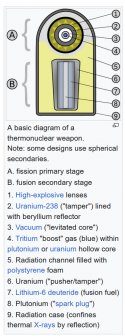What
@bustead is talking about is the primary stage of the weapon. The depleted uranium is used in the tamper in the secondary. You need a small fission (fusion-boosted fission, to complicate matters further) bomb to set off a much larger fusion bomb. The neutrons given off by the fusion reactions are energetic enough to fission U-238, which increases the bomb's yield. A lot of the yield comes from fission of this tamper by neutrons from the fusion.
1) A chemical explosive implodes a hollow sphere, called a pit (modern designs use other geometries like ellipsoids) of fissile material (U235 or Pu239) filled with deuterium-tritium gas. This causes a nuclear chain reaction which releases enough heat to fuse the DT gas. Neutrons released from this fusion improve the fission in the pit.
2) X-rays and gamma rays from this nuclear explosion are channeled by the interstage into the hohlraum, the radiation cavity housing the secondary stage.
3) The secondary stage is another spheroid with a tamper (an outer shell made of depleted uranium), an outer core of lithium deuteride, and an inner core of fissile material (called a spark plug). The channeled X-rays/gamma rays heat the tamper to such a degree that material ablates from it in jets, the reactive force of which implodes the secondary.
4) The imploding secondary crushes the fissile material at the core, which starts a fission chain reaction. Neutrons from this reaction fission the lithium in the outer core, and the heat and pressure start fusion reactions in the fusion fuel.
5) Very fast neutrons released by the fusion reaction fission the depleted uranium tamper. Note that this isn't a chain reaction, this is a massive flux of very energetic neutrons fissioning a material that can't sustain a chain reaction.
As you can see, the only places fissile material is used is in the pit and the spark plug. This is why modern devices that leverage all these principles and techniques can use relatively little fissile material (a few kilograms is sufficient for hundreds of kilotons yield). There are other tricks that can be used, like surrounding the pit with beryllium, a material that reflects neutrons, so less fissile material is needed to sustain a chain reaction.

